Vietnam Airlines
|
||||
| Founded | 1956 (as Vietnam Civil Aviation) | |||
|---|---|---|---|---|
| Hubs |
|
|||
| Secondary hubs | Da Nang International Airport | |||
| Focus cities | ||||
| Frequent-flyer program | Golden Lotus Plus | |||
| Member lounge | Golden Lotus Lounge | |||
| Alliance | SkyTeam[2] | |||
| Subsidiaries |
|
|||
| Fleet size | ~ 70 [3](+70 orders) incl. cargo (150 by 2020)[4] | |||
| Destinations | 64 (including code-shares)[5] | |||
| Company slogan | Bringing Vietnamese Culture to the World | |||
| Parent company | Vietnam Airlines Corporation | |||
| Headquarters | ||||
| Key people | ||||
| Website | www.vietnamairlines.com www.vietnamairlines.com/cargo |
|||
Vietnam Airlines Company Limited[8] (Vietnamese: Tổng Công ty Hàng không Việt Nam), trading as Vietnam Airlines (Vietnamese: Hãng Hàng không Quốc gia Việt Nam), is the national flag carrier of Vietnam. It was established as a state enterprise in April 1989, and is headquartered in the Long Bien district of Hanoi,[4] with hubs at Noi Bai International Airport and Tan Son Nhat International Airport. From there, the airline flies to 62 destinations in 19 countries, including code-shares, using its fleet of 70 airplanes.
Vietnam Airlines was subsequently formed in 1993, after bringing together several service companies. The company is overseen by a seven-seat management board, members of which are appointed by the Vietnamese Prime Minister.[9] Vietnam Airlines used to be the major stakeholder in Vietnam's second largest carrier, Jetstar Pacific Airlines, but its share has recently been transferred to the Ministry of Finance, then subsequently, to the State Capital Investment Corporation (SCIC).[10]
With the core activity of the airline being passenger transportation, Vietnam Airlines also earns revenue from catering and the maintenance and overhauling of aircraft through a number of its subsidiaries. The maintenance and overhauling of aircraft is handled by Vietnam Airlines Engineering Company (VAECO), while the former is performed by Noibai Catering Services Join-Stock Company and Vietnam Air Caterer, who cater airlines that use Vietnam Airlines’ hubs for the flag carrier. The airline also controls and operates its cargo division, Vietnam Airlines Cargo, using the airline’s luggage hold on its passenger fleet, as well as a number of dedicated airplanes. Vietnam Airlines owns 100% of Vietnam Air Service Company (VASCO)—a regional airline in southern Vietnam, and 49% of Cambodia Angkor Air—the national flag carrier of Cambodia.
The airline is ranked as a three star airline according to the independent research consultancy firm Skytrax.[11] Vietnam Airlines became a member of SkyTeam on June 10, 2010 making it the sole Southeast Asian carrier to join that airline alliance.[12][13] During the months of September and October 2010, Vietnam Airlines is slated to manage all the transportation for the Miss World beauty pageant in its capacity as the official airline of the contest,[14] although recent rumours of Vietnam's withdrawal as host have cast doubt on this.[15][16] Recently, Miss World has decided to hold the contest in Sanya, People's Republic of China.[17]
Contents |
History
Beginnings
Vietnam Airlines can trace its roots back to 1956,[18] when it was established by the North Vietnamese government after the nationalizing of Gia Lam Airport; back then the airline’s name was Vietnam Civil Aviation. It was instituted after the government signed the Decree. 666/TTg.[19][20] The airline was created as part of the air force, which was to be used for civilian purposes.[21] Its fleet consisted of five aging Soviet-supplied planes - one Il-14, one An-2 and three Aero 45s;[22] this was due to the fact that there was an embargo that prohibited the airline leasing and/or buying American technology or components.[23]
Its first international destination was Beijing, followed by Vientiane in 1976.[24] During that year, the airline was known as General Department of Civil Aviation in Vietnam, and began full operations, carrying around 21,000 passengers, of which one-third were on international flights and 3,000 tonnes of cargo.[18] In 1978, another important destination of Vietnam Airlines was added, with flights offered to Bangkok.[24]
During the late 1980s and early 1990s saw the airline expanding its route maps to Hong Kong, Kuala Lumpur, Manila and Singapore.[24] In 1992 the airline was able to acquire the American-built jets in the form of the Boeing 737 and Boeing 767.[3] It was able to do so by chartering the planes, instead of leasing or buying them, and by painting them white.[23] Also, during this time, many more destinations like Paris, Tokyo, Seoul, Taipei, Sydney and Melbourne were added.[22]
New corporation: 1993 and onwards

In 1993, the airline completed its restructuring programme which had been started four years earlier. It involved officially changing its name to the present Vietnam Airlines Corporation.[18][25] Several services companies were incorporated into the new corporation afterwards.
On September 1996, Vietnam Airlines started offering Business Class services and three years later, on the eve of the second millennium, the airline launched its frequent flyer program, Golden Lotus Plus.
On 20 June 2005, the airline launched services to Germany, with 2 and 1 flights between Frankfurt and Hanoi and Ho Chi Minh City, respectively. It came after the 2004-2005 period where travel between the two countries soared 70 percent.[26][27]
In 2006, Vietnam Airlines was admitted into IATA, the biggest aviation association in the world.[28][29][30] As part of the move, Vietnam Airlines had to meet the association’s IOSA safety standards.[31]
Recent developments
According to a number of newspaper reports, the news of the Vietnamese government planning to partially equitize (privatise) Vietnam Airlines was released in 2007.[32] In the plan, the government considered selling 20 to 30 percent of the airline’s staked to outsiders, with the rest retained by the government. This was a small part of a bigger proposal by the government to privatize its state-owned companies, due to be completed by 2010.[33] The airline was given the permission the following year,[34][35] however, the plan came to nothing as the airline missed its deadline scheduled by the government, which was arranged for 2010,[36], due to the Global Financial Crisis.[37]
During the year 2008, Vietnam was chosen as the host of Miss World’s 60th contest.[38] Naturally, being the host country’s flag carrier, Vietnam Airlines was selected as the sponsoring airline for the contest.[14][39] As a official airline of the beauty pageant, the airline was tasked the job of managing all the transportation for the contest, to be carried out during the months of September and October before the competition starts. However, Miss World has decided to hold the 60th contest in 2010 in Sanya, People's Republic of China, following speculations of Vietnam withdrawing.[17]
A new website was launched by Vietnam Airlines on 10 October 2009 to make bookings easier. The website also helps passengers with non-Vietnamese backgrounds through the use of translation.[40] On 26 August 2010, the airline teamed up with Boeing during the unveiling of its interior modernisation programme in order to increase passenger comfort.[41]
Future
With the arrival of the eighty recently ordered airplanes for the duration of the next ten years, Vietnam Airlines is considering significantly expanding its route map. The airline is particularly interested in launching services to the U.S., where more than 1.2 million Vietnamese currently reside.[42] Such plans have been confirmed in December 2003, but have since been postponed due to the fact that Vietnam is not yet part of FAA's aviation safety assessment programme.[43] However, the airline is expected to launch the service in early 2011.[43][44]
Vietnam Airlines also is working towards launching flights to the Middle East and Indian subcontinent as well as starting more flights to other destinations in Australia and Europe. During an interview with Sabre Airline Solutions, CEO Pham Ngoc Minh says:
...apart from the United States, we are considering opening new routes such as Ho Chi Minh City/Hanoi, Vietnam-London; Ho Chi Minh City/Hanoi-Shanghai/Beijing, China; Ho Chi Minh City-Mumbai, India; Ho Chi Minh City-Brisbane, Australia; and Ho Chi Minh City-Doha, Qatar.[45]
While the airline had launched flights to Beijing and Shanghai, flights to London, Mumbai, Qatar and Brisbane have not been achieved.
Corporate affairs and identity
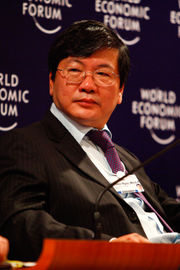
Vietnam Airlines is a owned by the government of Vietnam.[46]:6[47] In 2005, it had a workforce of over 14,000 employees, of whom 9,000 worked for the airline. The airline is headed and overseen by a seven-seat management team, members of which are selected by the Prime Minister of Vietnam.[25] Currently, Nguyen Sy Hung is the chairman of the company, with Pham Ngoc Minh being the President and CEO.
Training
According to the Director General of the Association of Asia Pacific Airlines, a trade association of Asian based airlines, Vietnam’s aviation industry lacks experience in the realm of pilot and crew training. However, Vietnam Airlines is effecting continual improvements in this field. Vietnam Airlines undertook plans to train 400 pilots shortly after the start of the year 2000.
Transportation of dangerous goods, cabin crew training, CRM (crew-resource management) and pilot training are all safety enhancing programs taught to airline personnel. New Vietnamese pilots are assigned as Western-type aircraft co-pilots. All pilots - both national and foreign - receive biannual simulator training and periodic line checks by Western pilots. A Hanoi-based Airbus cabin mock-up is specifically used for smoke and evacuation training.[9]
The Civil Aviation Authority of Vietnam signed a contract with Sofréavia of France to set up a pilot training school in the central province of Phu Yen in late 1998. To date, this has not been completed. Only 40 per cent of Vietnam Airlines’ aircraft are captained by Vietnamese citizens, all of whom are required to attend training programs abroad. Many pilots have received training at the Flight Training Adelaide in Adelaide, Australia.[48]
Financial performance
Vietnam Airlines has enjoyed good growth and an average of 37 per cent increase in passengers flown per year until 1997, when the Southeast Asian economic crisis and other contributing causes led to a loss in profits for the airline. Nevertheless, the airline remained profitable throughout the crisis. In 1996 and 1997, the airline posted profits exceeding US$100 million each year. In 1998, the airline saw its profit shrink to approximately US$7 million. Profits increased to US$59 million in 1999. Following the September 2001 attacks on the United States, at a time when many airlines were struggling, Vietnam Airlines saw a spike in passenger revenues. The airline carried more than 4 million passengers in 2002, which is an 18 per cent increase over the previous year.[49] Its cargo traffic also climbed 20 per cent during the same period, resulting in a 2002 profit of US$35.77 million.[49] Despite the Severe Acute Respiratory Syndrome outbreak, the airline posted a US$26.2 million profit for 2003. In 2006, it carried 6.8 million passengers (3.7 million international) and earned revenue of nearly US$1.37 billion (first 11 months). Vietnam Airlines carried more than 8 million passengers, of which 3.3 million were international travellers in 2007,[9] the year which saw the airline earning a gross profit of US$23 million[50]. As well as that, it also transported 115,100 tonnes of cargo. In 2009, the airline's revenue was US$1.3 billion, compared to US$1.56 billion it earned the previous year. During this period, Vietnam Airlines carried 9.3 million passengers[51]. According to Anna.Aero, Vietnam Airlines’ passenger capacity for 2010 has risen 30% over the same period of the previous year. This also coincides with the increase in capacity at Vietnamese airports, at 21%.[52]
Vietnam Airlines holds about 40 per cent of the market share of international tourists flying to and from Vietnam.[9] This is significant because Vietnam Airlines receives two-thirds of its profits from international passengers.
Vietnam Airlines is enjoying its current financial situation and is planning to increase its fleet size and destinations in the coming years.
Subsidiaries
- Noibai Airport Service Joint-stock Company (NASCO)
- Vietnam Air Petrol Company (VINAPCO)
- Vietnam Airlines Aviation Printing Joint-Stock Company (AVIPRINT)
- Middle Airport Service Company (MASCO)
- Noibai Cargo Terminal Service (NCTS)
- Air Service Supply Join-Stock Company (AIRSERCO)
- General Aviation Import-Export Join-Stock Company (AIRIMEX)
| Company | Type | Principal activities | Incorporated in | Group's Equity Shareholding |
|---|---|---|---|---|
| Vietnam Airlines Engineering Company (VAECO) | Subsidiary | Aircraft maintenance | Vietnam | 100% |
| Vietnam Air Service Company (VASCO) | Subsidiary | Passenger transportation | Vietnam | 100% |
| Cambodia Angkor Air | Joint venture | Passenger transportation | Cambodia | 49% |
| Noibai Catering Services Join-Stock Company | Subsidiary | Catering | Vietnam | 100% |
| Vietnam Air Caterers | Joint venture | Catering | Vietnam | 65% |
| Vietnam Air Leasing Company (VALC) | Joint venture | Aircraft leasing | Vietnam | 20%[53] |
Aircraft maintenance and production
Vietnam Airlines is increasingly becoming more involved in the maintenance, overhauling and production of aircraft.
As of 1 May 1992, Vietnam Airlines began conducting its own western-built aircraft repair and maintenance, starting with French-Italian turboprop ATR-72. Vietnamese technicians have since conducted repairs and maintenance of Boeing 737, Airbus A320, and Fokker F70 aircraft, and began maintenance checks on Boeing 767 aircraft in 1999, Boeing 777 aircraft in 2002.
Starting from 1 January 2009, Vietnam Airlines Engineering Company (VAECO) was established.[54][55] VAECO was organized based on A75, A76 main bases and Da Nang technical department.[9] The VAECO is taking responsibility for maintaining and technical services for Vietnam Airlines’ aircrafts and the other airlines.This establishment opens a new era of aircraft maintenance field in Vietnam. VAECO in the near future plans to become the reliable aircraft MRO service provider in Southeast Asia region.
Scheduled maintenance intervals are relatively conservative and follow the manufacturers' recommendations. Major engine and propeller maintenance is contracted to qualified overseas maintenance facilities, although a shift to performing more maintenance in-house is currently taking place. There have been no serious maintenance discrepancies with Vietnam Airlines in its history. Maintenance of Vietnam Airlines has been rated as one of the best in the world, and has passed many audits by competent regulatory bodies - including IOSA - without any remarkable findings.
In addition to its self maintenance facilities, Vietnam Airlines also has maintenance contracts with Air France, AMECO of China, China Airlines, Evergreen Aviation Technologies, GAMECO, Hong Kong Aircraft Engineering Co, Lufthansa AERO, MTU Maintenance Hanover, Royal Brunei Airlines, Safe Air of New Zealand, and TAT Industries of France.[9]
There are currently no production facilities in Vietnam for aircraft and aircraft parts. However, Boeing has managed to obtain 35 per cent of the distribution market in Vietnam, and General Electric, in turn, supplies jet engines for the Boeing aircraft. For the future, conversely, Vietnam Airlines is planning to build a maintenance factory in conjunction with Rolls Royce and other campanies.[56][57] It has also signed an MoU with European Aeronautic Defence and Space Company (EADS), which would let the corporation assemble and manufacture plane components in the future.[58]
Destinations

Vietnam Airlines has an extensive network throughout East Asia, Southeast Asia, Europe and Oceania. With more than 290 daily flights,[2] the airline flies to 20 destinations domestically, and to another 28 internationally.[5] In addition, it has code-share agreements with a number of airlines for 16 other routes, some of which span to North America. Recently, the airline has announced that it would open new routes to Can Tho, Vietnam[59][60] and to Shanghai, People’s Republic of China,[61] with the commencement date scheduled on 28 and 29 of March 2010, respectively. Direct services to the Americas are contingent on the arrival of Vietnam Airline's state-of-the-art Boeing 787-9 Dreamliner.
Vietnam Airlines also announced that they are considering a direct flight from Yangon to Ho Chi Minh City.
Alliance
Vietnam Airlines is currently a member of SkyTeam and codeshares with all SkyTeam members. Vietnam Airlines also has code-shares with four current Oneworld members - American Airlines, Cathay Pacific, Japan Airlines, and Qantas and is part of Cathay Pacific Airways's Asia Miles program. In April 2010, the airline struck a deal with the Air France division of Air France-KLM Group, which will see Vietnam Airlines flying to Paris using the Air France’s AF flight code. Vietnam Airlines joined SkyTeam on June 10, 2010.[62][63][64][65][66][67][68][69][70][71][72][73][74][75]
| “ | We believe that the cooperation among SkyTeam member airlines will facilitate the expansion of flight network, the sharing of experiences and the application of advanced technology. | ” |
|
—President and Chief Executive Pham Ngoc Minh[68] |
||
As of August 2010, Vietnam Airlines has codeshare agreements with the following airlines:[4]
|
|
|
In addition, Vietnam Airlines has interline agreements with many other airlines, such as Belavia of Belarus,[77] S7 Airlines of Russia,[78] and Virgin Blue of Australia.[79][80] Malaysia Airlines, etc. Also, following Vietnam Airlines' entry into SkyTeam on June 10, 2010, it codeshares with other SkyTeam members.
.jpg)
Fleet
Passengers
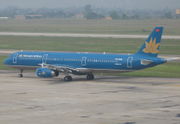

Vietnam Airlines currently operates a mixed fleet of sixty leased and brand new turboprops and jet airliners, with European aircraft making up most of the fleet, with the rest being American. Prior to the lifting of the trade embargo between the US and Vietnam by former president Bill Clinton back in 1994, Soviet airplanes were the primary jets used by the airline.
The airline started out with five Soviet airplanes.[22] During its early days, it wasn’t able to use American airplanes due an embargo against the airline. In 1992 Vietnam airlines acquired a number of Boeing 737s and Boeing 767s by chartering the planes, instead of leasing or buying them.[22] Later, the airline purchased two 80-seat ATR-72s, made by the French company Avion de Transport Régional. Following the crash of the airline’s Tupolev Tu-134 at Phnom Penh in 1997, it has undergone a fleet replacement, retiring the old Soviet planes and replacing them with newer Airbus and Boeing aircraft.[81]
Modernisation
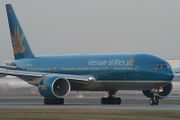
In the wake of the 1997 crash in Phnom Penh, Vietnam Airlines began a fleet replacement programme, retiring its second-hand Boeing 767s and phasing out all of its Soviet-built airliners, replacing them with newer Western-built aircraft.
In December, 2001, Vietnam Airlines signed a historic agreement with Boeing. It ordered its first ever US-built aircraft, signalling the start of trade under the Bilateral Trade Agreement between the two countries. The airline ordered four Boeing 777-200ERs, to be delivered in 2003.[82][83] With a range of 14,260 km, capable of flying non-stop in excess of 17 hours, these aircraft are able to fly from Ho Chi Minh City to Los Angeles.[84] The four airplanes, as well as six other Boeing 777s leased from International Lease Finance Corporation (ILFC), are the flagships of the airline, and are deployed mainly on long-haul flights to Australia and Europe, as well as flights between the airline’s hubs.[3]
In September 2005, Vietnam Airlines ordered eight Boeing 787-8 aircraft[85][86] and 10 Airbus A321-200s for deliveries starting from 2009. These new aircraft were to allow Vietnam Airlines to expand its network and replace some leased aircraft.[87] However owing to delays in the 787 program, Vietnam Airlines has only received the A321s. Regarding the delays from Boeing, Vietnam Airlines CEO Pham Ngoc Minh noted, "We are not happy about the constant delays. It affects our business plan."[88][89] In 2010 the airline changed its Boeing 787 order to the -9 model, stating that the 787-8s didn't meet all the requirements Boeing initially promised.[90][91] The airline is now expected to receive its aircraft starting from 2013.
On 1 October 2007 Vietnam Airlines signed an MoU for the purchase of 10 Airbus A350s,[92] and an additional 20 Airbus A321s.[92][93] The Airbus A350s will supplement the Boeing 787s already ordered by the airline.[93] This single order will result in Vietnam Airlines becoming one of the largest Airbus operators in Asia.[94] Two years later the airline signed another deal for sixteen extra Airbus A321s and two Airbus A350s during the 2009 Paris Air Show.[95][96]
Later in 2009 Vietnam Airlines signed an MoU with Airbus, confirming its negotiations to order four Airbus A380s.[97] With this deal, the airline became the first new customer for the type since 2006.[98] According to Vietnam Airlines, these aircraft will allow Vietnam Airlines to expand its services into North America, as well as launch its Intercontinental First Class cabins.[99] Vietnam Airlines is particularly interested in a higher-weight variant of the A380-800 that is currently under development.[100]
As of 1 April 2010, the average age of the Vietnam Airlines fleet is 7.4 years.[101] The Vietnam Airlines fleet consists of the following aircraft (as of 10 June 2010):[3][102]
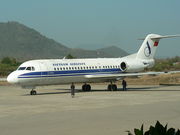
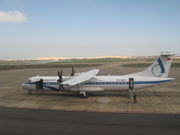
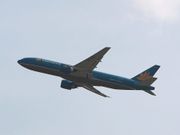
| Aircraft | Total | Order | Passengers (Business/Deluxe Economy/Economy) |
Notes |
|---|---|---|---|---|
| Airbus A320-200 | 10 | 0 | 162 (0/0/162) 150 (12/0/138) |
Short-haul international and domestic |
| Airbus A321-231 | 21 | 29 | 184 (16/0/168) | 1 unit being leased to Cambodia Angkor Air[103] Deliveries: 2008-2011 (16 new A321-231s in 2010)[104] Short- and medium-haul international and domestic |
| Airbus A330-200 | 8 | 0 | 266 (24/0/242) | AVOD in-flight entertainment Medium-haul international and domestic |
| Airbus A330-300 | 1 | 0 | 320 (36/0/284) | AVOD in-flight entertainment Medium-haul international and domestic |
| Airbus A350-900 | 0 | 12[92] | TBA | Entry into service: 2014 Long-haul international |
| Airbus A380-800 | 0 | 4[99] | TBA | Entry into service: 2015 MoU was signed with Airbus regarding the purchase in November 2009; negotiations are underway and may change to the -900 versions Long-haul international |
| ATR 72 | 14 | 12 | 66 (0/0/66) | 2 units being leased to Cambodia Angkor Air[103] Short-haul international and domestic |
| Boeing 777-200ER | 10 | 0 | 307 (25/54/228) 325 (35/0/290) 338 (32/0/306) |
AVOD in-flight entertainment Long-haul international and domestic |
| Boeing 787-9 | 0 | 16[85] | TBA | Entry into service: 2016 originally 787-8 models, but changed to -9 in June 2010[90] Long-haul international |
| Fokker 70 | 2 | 0 | 79 (0/0/79) | Short-haul international and domestic |
| Total | 70 | 70 |
Cargo
Vietnam Airlines Cargo is the air freight division of Vietnam Airlines, providing cargo service to destinations in Asia, Europe, North America and Oceania, through their own network as well as partners' network. It also operates the International Cargo Terminal, which is a joint venture with Singapore Airport Terminal Service, at Tan Son Nhat International Airport. The division has the number of following aircraft:[105][106]
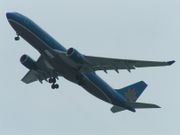
| Aircraft | Total | Order | Notes |
|---|---|---|---|
| Airbus A300 | 3 | 0 | freight capacity: 13 tonnes |
| Airbus A320 family | 2 | 0 | freight capacity: 2.5 tonnes |
| Airbus A330 | 2 | 0 | freight capacity: 15 tonnes |
| Boeing 777-200ER | 3 | 0 | freight capacity: 13–17 tonnes |
Retired
Since its conception in 1956, the airline has operated a wide range of aircraft. This varies between Russia, American, and European airplanes. However, the airline currently only utilises American Boeings, and European ATRs, Airbus’s and Fokkers, retiring and scrapping the unreliable Soviet made planes, because they were involved in all of the airline’s crashes. However, one Tu-134 and Ilyushin Il-18 have been retained as possible future museum exhibits, and are presently parked at the apron of Noi Bai International Airport.[25]
Below is a list of retired Vietnam Airlines airplanes (with the number of aircraft in brackets):[3][4]
|

A Vietnam Airlines Boeing 767 in old livery
|
Services
Entertainment
A wide range of entertainment is offered on Vietnam Airlines flights, including movies, video games, music, newspapers and magazines. On long-haul international flights served by some Boeing 777-200ERs, seats in all cabin classes are equipped with Audio Video on Demand (AVOD) in-flight entertainment via personal televisions. Vietnam Airlines offers two in-flight magazines, Heritage and Heritage Fashion, on board both domestic and international flights.
Cabins
Business
Business class is the highest of three cabin classes offered by the airline. Introduced in 1996, the cabin is available on most of Vietnam Airlines’ route network. As is the case with business class cabins in most airlines, the amenities offered in this class are substantially different from economy class, and more services and products are available, either for purchase or free of charge.
On Boeing 777s, business class seats are 61.3 cm (24 in.) wide with 150 cm (60 in.) of leg room (69 cm more than in economy class), and are able to recline with a pitch of 150 degrees.[107][108] Laid out in a 2–3–2 configuration,[109] each seat is equipped with lumbar support[110] and a 10.4 in. personal touch screen, capable of delivering AVOD.[107] Noise-cancelling headphones are offered on selected Boeing 777 flights. On international flights, newspapers magazines from around the world, such as The Times and Newsweek are offered free of charge.[107]
Hot meals are offered on flights lasting longer than 2 hours; on board flights to and from Australia, Europe, Korea and Japan, meals generally offer a combination of Eastern and Western cuisines. Wines and spirits, as well as other drinks and beverages, are on offer as well.[108]
Deluxe Economy
Deluxe economy, Vietnam Airlines’ equivalent of premium economy, has a wider seat width and legroom compared to Economy at 97 cm (40 in.), and is laid out 3–3–3.[25][109] This class is offered only on selected Boeing 777 flights. On flights over 90 minutes, snacks are served; on 2-hour plus flights, as in business class, hot meals are served.[111] Fruit juices, coffee, beverages and tea are also served.
Economy
Economy class is available on all flights operated by Vietnam Airlines. Seats in this cabin feature seats ranging from 20 in. (Airbus A330) to 20.9 in. (Boeing 777) in width.[112]. Seat pitch on this cabin class is 31–32 in., while seat recline is from 6 to 13 degrees.[112] Like Deluxe Economy, snacks are served on flights over 90 minutes, with hot meals available on flights that are 2 hours or more. Like the two other cabin classes, beverages, fruit juices and tea are served, but the range on offer is smaller.[113]


Lounges
Vietnam Airlines offers the use of business lounges to VIPs, business class travellers and Golden Lotus Plus Gold members. Passengers using these lounges are entitled to such amenities as free wireless internet, shower facilities and bar services. In addition, private suites are available, enabling users to work quietly, and food services are free. On code-share flights, lounges of other airlines are used.
The following airports have business lounges provided either by Vietnam Airlines or by code-share partners:
|
|
Loyalty programme
Vietnam Airlines has been offering Golden Lotus Plus, a frequent flyer and loyalty programme, to its customers since 1999. It has 4 levels: Platinum, Gold, Titanium, and Silver. Members can receive free services and benefits, according to the level in which they belong to.
| Tier Level | Benefits | Requirements | SkyTeam Status |
|---|---|---|---|
| Silver |
|
|
- |
| Titanium |
|
|
Elite |
| Gold |
|
|
Elite |
| Platinum |
|
|
Elite Plus |
Incidents and accidents
Vietnam Airlines has experienced three fatal and several non-fatal incidents in the last 22 years. All fatal incidents have involved Soviet made aircraft that have since been phased out of service. These incidents occurred on final approach or landing, and all three fatal crashes occurred in driving rain. Vietnam Airlines has recorded two hijackings.
See also
- Da Nang International Airport
- Indochina Airlines
- Jetstar Pacific Airlines
- Transport in Vietnam
- VietJet AirAsia
- Vietnam Airlines Flight 815
Footnotes
- Notes
- 1.^ Please see Golden Lotus Plus for further information.
- References
- ↑ Dong, Ha (12/20/06). "Second southern international airport has $8bln price tag". ThanhNien News (Vietnam: ThanhNien News). http://www.thanhniennews.com/2006/Pages/200612201035340.aspx. Retrieved 14 February 2010.
- ↑ 2.0 2.1 SkyTeam (10/6/10). "Vietnam Airlines Joins SkyTeam". Press release. http://www.skyteam.com/news/headlines/20100610.html. Retrieved 25 June 2010.
- ↑ 3.0 3.1 3.2 3.3 3.4 "Vietnam Airlines Details and Fleet History". PlaneSpotters.net. 1 April 2010. http://www.planespotters.net/Airline/Vietnam-Airlines. Retrieved 1 April 2010.
- ↑ 4.0 4.1 4.2 4.3 4.4 4.5 4.6 4.7 4.8 "About Us". Vietnam Airlines. http://www.vietnamairlines.com/wps/portal/en/site/about_us/our_background/!ut/p/c5/hY5LDoJAEAXPwgnm0QwMLIffAAIaohHZGBbGYARcGM8vuNIxaPeyUnnFGjb90D66c3vvxqG9spo1zjFQMuEiB9aO7YDi0FspKzRR8Ykf3rhLXgQqc2zSTAKKf9igrT9RRabIMytwSbNVUcQgsXNFFZUmYP_Z3s-1i-sqsX_yV93MsXASmq8V-ELj3_1lMvYndut3Nbr0wqVhPAFC4vMb/dl3/d3/L2dBISEvZ0FBIS9nQSEh/. Retrieved 8 October 2009.
- ↑ 5.0 5.1 "Vietnam Airlines Route Map". Vietnam Airlines. 2010. http://www.vietnamairlines.com/wps/portal/en/site/flight_info/route_map. Retrieved 2 April 2010.
- ↑ "Airline Membership". IATA. http://www.iata.org/membership/Pages/airline_members_list.aspx?All=true.
- ↑ 7.0 7.1 7.2 "Vietnam Airlines Board of Directors". BusinessWeek. 29/3/10. http://investing.businessweek.com/research/stocks/private/people.asp?privcapId=8182368. Retrieved 30 March 2010.
- ↑ Nguyen, Binh (25/6/10). "Vietnam Airlines becomes limited liability company". The Saigon Times. http://english.thesaigontimes.vn/Home/business/other/11036/. Retrieved 27 June 2010.
- ↑ 9.0 9.1 9.2 9.3 9.4 9.5 "Doing Business in Vietnam". 17/3/08. http://www.buyusa.gov/vietnam/en/265.pdf. Retrieved 6 March 2010.
- ↑ "Qantas duo rescued from Vietnam". The Sydney Morning Herald. 30/7/10. http://www.smh.com.au/business/qantas-duo-rescued-from-vietnam-20100729-10y2n.html. Retrieved 30 July 2010.
- ↑ "Vietnam Airlines: 3-Star Ranking of Product and Services Quality". SkyTrax. http://www.airlinequality.com/Airlines/VN.htm. Retrieved 19 February 2010.
- ↑ "Vietnam Airlines and TAROM on track to become members in June". The Netherlands: SkyTeam.
- ↑ "Vietnam Air to become full SkyTeam member in June". VietnamNet (VietnamNet). 27/5/10. http://english.vietnamnet.vn/travel/201005/Vietnam-Air-to-become-full-SkyTeam-member-in-June-912706/. Retrieved 28 May 2010.
- ↑ 14.0 14.1 "Vietnam Airlines to manage transport for Miss World 2010". Travel Vietnam (Vietnam: Travel Vietnam). 2007. http://www.sai-gon-hotels.com/Vietnam-Airlines_1632. Retrieved 14 February 2010.
- ↑ "Vietnam should withdraw as Miss World 2010 host: official". SaiGon Giai Phong (Vietnam). 17/3/10. http://www.saigon-gpdaily.com.vn/Culture_Art/2010/3/80319/. Retrieved 4 May 2010.
- ↑ "Miss World 2010 relocation scandal brewing". LookAtVietnam (Vietnam). 26/10/09. http://www.lookatvietnam.com/2009/10/miss-world-2010-relocation-scandal-brewing.html. Retrieved 4 May 2010.
- ↑ 17.0 17.1 "China 2010". Miss World. http://www.missworld.com/Missworld/new-venue.html. Retrieved 14 July 2010.
- ↑ 18.0 18.1 18.2 "Vietnam Airlines". Vinafour. http://www.vinafour.com/airline/vietnam-airlines-1. Retrieved 20 February 2010.
- ↑ "A Strategy for the Vietnam Civil Aviation Administration to Promote US-Vietnam Bilateral Civil Aviation Agreement". http://www.commercialdiplomacy.org/pdf/ma_projects/nguyen_chi.pdf. Retrieved 15 May 2010.
- ↑ "A Strategy for the Vietnam Civil Aviation Administration to Promote US-Vietnam Bilateral Civil Aviation Agreement". http://www.commercialdiplomacy.org/ma_projects/nygyuen.htm. Retrieved 15 May 2010.
- ↑ "L'aviation civile vietnamienne" (in French). http://chimviet.free.fr/quehuong/ngcaoduc/gm68_AviationCivileVN.pdf. Retrieved 23 June 2010.
- ↑ 22.0 22.1 22.2 22.3 "Airlines in Vietnam". Indochina Travel Service. http://www.indochinatravelservice.com/flight/Airlines_in_vietnam.html. Retrieved 20 February 2010.
- ↑ 23.0 23.1 Buckley, Michael. "Flying Ghost". http://www.veloasia.com/library/buckley/flying_ghosts.html. Retrieved 24 February 2010.
- ↑ 24.0 24.1 24.2 "Fly to Vietnam with Vietnam Airlines". travelclearance.com.au. http://www.travelclearance.com.au/vietnam-airlines. Retrieved 20 February 2010.
- ↑ 25.0 25.1 25.2 25.3 Thomalla, Volker K. (September 2005). "Vietnam Airlines Expands". Flug Revue (magazine). http://www.flug-revue.rotor.com/FRheft/FRHeft05/FRH0509/FR0509c.htm. Retrieved 10 April 2010.
- ↑ "Vietnam Airlines heads directly to Germany". New York Times. 1/6/05. http://www.nytimes.com/2005/05/31/travel/31iht-travel1.html. Retrieved 25 June 2010.
- ↑ "Vietnam Airlines to start direct flights to Germany in June". Forbes. 31/1/05. http://www.forbes.com/feeds/afx/2005/05/31/afx2064589.html. Retrieved 25 June 2005.
- ↑ "Vietnam Airlines becomes IATA member". VoV News (VoV News). 1/3/07. http://english.vovnews.vn/Home/Vietnam-Airlines-becomes-IATA-member/20073/28204.vov. Retrieved 9 June 2010.
- ↑ "Vietnam Airlines joins IATA". Vietnam Net (Vietnam Net). 8/12/06. http://english.vietnamnet.vn/biz/2006/12/642147/. Retrieved 9/ June 2010.
- ↑ "SkyTeam Signs Preliminary Membership Agreement With Vietnam Airlines". PR Newswire, SkyTeam. redOrbit. 15/4/09. http://www.redorbit.com/news/business/1671167/skyteam_signs_preliminary_membership_agreement_with_vietnam_airlines/. Retrieved 9 June 2010.
- ↑ "Vietnam Airlines meets int’l air safety standards". VoV News (VoV News). 14/7/06. http://english.vovnews.vn/Home/Vietnam-Airlines-meets-int039l-air-safety-standards/20067/33408.vov. Retrieved 9 June 2010.
- ↑ "Vietnam Airlines to go public next year". People’s Daily Online (China, People’s Republic of). 2/1/07. http://english.people.com.cn/200701/02/eng20070102_337721.html. Retrieved 12 April 2010.
- ↑ "Vietnam to partially privatize 71 large state-owned enterprises". ChinaDaily.com.cn (China). 2/1/07. http://www.chinadaily.com.cn/world/2007-01/02/content_773497.htm. Retrieved 12 April 2010.
- ↑ "Vietnam Airlines may go public this year". People’s Daily Online. 15/1/08. http://english.people.com.cn/90001/90778/90858/90863/6338795.html. Retrieved 12 April 2010.
- ↑ "Vietnam Airlines to sell stake to foreign partners". ThanhNien News (Vietnam). 19/6/08. http://www.thanhniennews.com/2008/Pages/2008619115236039466.aspx. Retrieved 12 April 2010.
- ↑ "Vietnam Airlines to miss equitization deadline". ThanhNien News (Vietnam). 15/1/10. http://www.thanhniennews.com/2010/Pages/201011518229054670.aspx. Retrieved 12 April 2010.
- ↑ Thomas, Beth title=Vietnam May Spur Privatization After $4.5 Billion Shipyard Debt (8/8/10). Bloomberg. http://www.businessweek.com/news/2010-08-08/vietnam-may-spur-privatization-after-4-5-billion-shipyard-debt.html. Retrieved 9 August 2010.
- ↑ "Vietnam to host Miss World 2010". Vietnam Net (Vietnam). 10/7/08. http://english.vietnamnet.vn/lifestyle/2008/07/792973/. Retrieved 12 April 2010.
- ↑ "Vietnam to manage transport for Miss World 2010". Vietnam Net (Vietnam). 12/7/08. http://english.vietnamnet.vn/lifestyle/2008/07/793314/. Retrieved 12 April 2010.
- ↑ "Vietnam Airlines launches new website". VoV News. 9/10/09. http://english.vovnews.vn/Home/Vietnam-Airlines-launches-new-website/200910/108688.vov. Retrieved 25 June 2010.
- ↑ "Vietnam Airlines and Boeing Team to Enhance 777 Passenger Experience". www.prnewswire.com. 26/8/10. http://www.prnewswire.com/news-releases/vietnam-airlines-and-boeing-team-to-enhance-777-passenger-experience-101539858.html. Retrieved 29 August 2010.
- ↑ "Statistical Abstract of the United States: 2009". U.S. Government. 2009. http://www.census.gov/prod/2008pubs/09statab/pop.pdf. Retrieved 29 June 2010.
- ↑ 43.0 43.1 Sobie, Brendan (24/6/10). "Vietnam Airlines aims to launch US services in early 2011". Flight Global. http://www.flightglobal.com/articles/2010/06/24/343609/vietnam-airlines-aims-to-launch-us-services-in-early.html. Retrieved 29 June 2010.
- ↑ "Vietnam Airlines says may start US flights in 2011". Bloomberg (Thanh Nien News). 7/6/10. http://www.thanhniennews.com/2010/Pages/20100607180627.aspx. Retrieved 29 June 2010.
- ↑ "Leaps and Bounds". Sabre Airline Solutions. 2008. http://www.sabreairlinesolutions.com/pdfs/LeapsAndBounds_OCT_2008.pdf. Retrieved 30 June 2010.
- ↑ "List of Government-owned and Privatized Airlines (unofficial preliminary compilation". http://www.icao.int/icao/en/atb/epm/ecp/PrivatizedAirlines.pdf. Retrieved 19 May 2010.
- ↑ "Vietnam Airlines". Centre for Asia Pacific Aviation. http://www.centreforaviation.com/profiles/airlines/vietnam-airlines. Retrieved 6 March 2010.
- ↑ "FTA Company Overview". FTA. http://www.flighttrainingadelaide.com/company-overview. Retrieved 12 April 2010.
- ↑ 49.0 49.1 "Vietnam Airlines". http://airlines.siegmann.org/vietnam-airline/?pg=4. Retrieved 6 March 2010.
- ↑ "Vietnam Airlines 2007 profit rises 6.4 pct". Thomson Reuters (Global: Thomson Reuters). 31/12/07 10:18am GMT. http://uk.reuters.com/article/idUKHAN960320071231. Retrieved 20 February 2010.
- ↑ "Vietnam Airlines 2009 profit falls 42 percent". ThanhNien News (Vietnam: ThanhNien News). 13/1/10. http://www.thanhniennews.com/2010/Pages/201011317551054645.aspx. Retrieved 20 February 2010.
- ↑ "China at the forefront of Asian air travel growth; Indonesia and Vietnam booming in 2010; Hong Kong, Japan and Thailand struggle". OAG Max Online. Anna.Aero. 25/5/10. http://www.anna.aero/2010/05/25/china-at-the-forefront-of-asian-air-travel-growth/. Retrieved 9 June 2010.
- ↑ "Vietnam enters leasing market". Orient Aviation. November 2007. http://www.orientaviation.com/storage/PDF/OAMag_V15N02/OAMag_V15N02_P60_Vietnam.pdf. Retrieved 4 June 2010.
- ↑ "Largest Airplane Maintenance Company Debuts". VOVNews.vn (Vietnam: VOVNews.vn). 25/2/09. http://english.vovnews.vn/Home/Largest-airplane-maintenance-company-debuts/20092/102113.vov. Retrieved 17 April 2010.
- ↑ "Largest airplane maintenance company debuts". SAGA Finance (Vietnam: SAGA Finance). 25/1/09. http://taichinh.saga.vn/English/kinhte/giaothongvantai/14832.asset. Retrieved 17 April 2010.
- ↑ "Rolls Royce to build an aircraft maintenance factory in Vietnam". VOV News. 12/3/10. http://english.vovnews.vn/Home/Rolls-Royce-to-build-an-aircraft-maintenance-factory-in-Vietnam/20103/113437.vov. Retrieved 7 June 2010.
- ↑ "Rolls Royce to build an aircraft maintenance factory in Vietnam". Vietnam Net. 13/3/10. http://english.vietnamnet.vn/biz/201003/BUSINESS-IN-BRIEF-13/3-898613/. Retrieved 7 June 2010.
- ↑ "Industry airs ambitious aviation plans". Viet Nam News. 1/3/10. http://vietnamnews.vnagency.com.vn/Economy/Business/197165/Industry-airs-ambitious-aviation-plans.html. Retrieved 7 June 2010.
- ↑ "Airlines offers new route discounts". Viet Nam News (Vietnam: Viet Nam News). 25/3/10. http://vietnamnews.vnagency.com.vn/Economy/198008/New-Satellite-TV-channel-beams-out-.html. Retrieved 25 March 2010.
- ↑ M, Vong (22/3/10). "Bay tuyến TP.HCM - Cần Thơ, Cần Thơ - Phú Quốc với 304.000 đồng" (in Vietnamese). Thanh Nien Online (Vietnam). http://www.thanhnien.com.vn/News/Pages/201013/20100322003304.aspx. Retrieved 25/3/10.
- ↑ Vietnam Airlines (2/3/10). "New service - Daily flight to Shanghai". Press release. http://www.vietnamairlines.com/wps/wcm/connect/en/site/news/moduongbaysha_en. Retrieved 2 March 2010.
- ↑ "Delta welcomes Vietnam Airlines into SkyTeam Alliance". MarketWatch.com. 10/6/10. http://www.marketwatch.com/story/delta-welcomes-vietnam-airlines-into-skyteam-alliance-2010-06-10?reflink=MW_news_stmp. Retrieved 10 June 2010.
- ↑ 63.0 63.1 "Vietnam Airlines joins Delta’s SkyTeam". Atlanta Business Chronicle. 10/6/10. http://atlanta.bizjournals.com/atlanta/stories/2010/06/07/daily47.html. Retrieved 10 June 2010.
- ↑ "Vietnam Airlines joins SkyTeam". Sai Gon Giai Phong (Sai Gon Giai Phong). 10/6/10. http://www.saigon-gpdaily.com.vn/Travel/2010/6/82821/. Retrieved 10 June 2010.
- ↑ "Vietnam Airlines joins the SkyTeam Alliance". Seattlepi.com. 10/6/10. http://blog.seattlepi.com/worldairlinenews/archives/210518.asp?from=blog_last3. Retrieved 10 june 2010.
- ↑ "Vietnam Airlines joins SkyTeam air alliance". The Economic Times (The Economic Times). 10/6/10. http://economictimes.indiatimes.com/news/international-business/Vietnam-Airlines-joins-SkyTeam-air-alliance/articleshow/6032357.cms. Retrieved 10 June 2010.
- ↑ "Vietnam Airlines Joins SkyTeam". SunHerald.com (SunHerald.com). 10/6/10. http://www.sunherald.com/2010/06/10/2247803/vietnam-airlines-joins-skyteam.html. Retrieved 10 June 2010.
- ↑ 68.0 68.1 Vu, Troung Khanh; Pham Muoi, Nguyen (10/6/10). "UPDATE: Vietnam Airlines Joins SkyTeam Airline Alliance". The Wall Street Journal (The Wall Street Journal). http://online.wsj.com/article/BT-CO-20100610-705494.html?mod=WSJ_World_MIDDLEHeadlinesAsia. Retrieved 10 June 2010.
- ↑ Vietnam Airlines (15/4/09). "SkyTeam signs preliminary membership agreement with Vietnam". Press release. http://www.vietnamairlines.com/wps/portal/en/site/about_us/press_room/!ut/p/c5/lY9LDoJAEETP4gmmGBgGlsOvAQGNkYhsDAtjMAIujOcXXAmKxu7ly0tVsZL131b3-lTd6q6tLqxgpXlwSYWGTICVKUzwwLOXpHsakej5_oVb3PbBswTrKFYAGSMbfOv0lLgmk1h3LT6xKU0DcJlbcuNnGiD-yh5zOPKHvRu2znanUHzlz20Dx8wpTPwP_Ub8fX0Wds2RXZs8L1BHZ0MtHnUmBQM!/dl3/d3/L0lDU0lKSWdrbUEhIS9JRFJBQUlpQ2dBek15cXchLzRCRWo4bzBGbEdpdC1iWHBBRUEhLzdfQ0dBSDQ3TDAwTzY1NjAyRkQ5S0czRDFHTzQvMV9fX182/?WCM_PORTLET=PC_7_CGAH47L00O65602FD9KG3D1GO4_WCM&WCM_GLOBAL_CONTEXT=/wps/wcm/connect/en/site/about_us/press_room/vna_skyteam_agreement. Retrieved 4 April 2010.
- ↑ "SkyTeam signs preliminary membership agreement with Vietnam Airlines". eTravel Blackboard (eTravel Blackboard). 17/4/09. http://www.etravelblackboard.com/showarticle.asp?id=91010. Retrieved 4 April 2010.
- ↑ "Vietnam Airlines moves to join SkyTeam alliance". AFP (Google). 15/4/10. http://www.google.com/hostednews/afp/article/ALeqM5j1OS56SejVzC4b06AECBzMK-HtqA. Retrieved 4 April 2010.
- ↑ "National carrier joins SkyTeam". VoV News (Vietnam: VoV News). 11/6/10. http://english.vovnews.vn/Home/National-carrier-joins-SkyTeam/20106/116412.vov. Retrieved 11 June 2010.
- ↑ "Flag carrier Vietnam Airlines to be member of SkyTeam". The China Post (China, People’s Republic of: The China Post). 10/610. http://www.chinapost.com.tw/business/asia/vietnam/2010/06/10/260161/Flag-carrier.htm. Retrieved 10 June 2010.
- ↑ "VN Airlines joins global alliance - first in SE Asia". Viet Nam News (Vietnam: Viet Nam News). 11 June 2010. http://vietnamnews.vnagency.com.vn/Economy/200444/VN-Airlines-joins-global-alliance---first-in-SE-Asia.html. Retrieved 11 June 2010.
- ↑ "Delta Welcomes Vietnam Airlines into SkyTeam Alliance". World Setinel. 10/6/10. http://www.worldsentinel.com/articles/view/162097. Retrieved 10 June 2010.
- ↑ "Air France strikes flight deal with Vietnam Airlines". Yahoo News (AFP). 2/4/10. http://news.yahoo.com/s/afp/20100402/bs_afp/francevietnamairlinecompanyairfrance_20100402171116. Retrieved 3 April 2010.
- ↑ Beata-Balarusian Telegraph Agency (29/05/2008 15:38). "Vietnam Airlines enter into interline-agreement". Press release. http://www.belta.by/en/news/society/?id=229169. Retrieved 20/2/10.
- ↑ website "About Us-Whole World with S7". S7 Airlines. http://www.s7.ru/en/about_us/partners/airline_partners.html website. Retrieved 20 February 2010.
- ↑ Virgin Blue (7/4/08). "A “V” GOOD PARTNERSHIP – VIRGIN BLUE AND VIETNAM AIRLINES SIGN INTERLINE AGREEMENT". Press release. http://www.virginblue.com.au/AboutUs/Media/NewsandPressReleases/P_003944.htm. Retrieved 12 March 2010.
- ↑ "Vietnam Airlines "bắt tay" với Virgin Blue" (in Vietnamese). Bao Moi (Vietnam: Bao Moi). http://www.baomoi.com/Info/Vietnam-Airlines-bat-tay-voi-Virgin-Blue/45/3283101.epi. Retrieved 12 March 2010.
- ↑ Susi, Bailey (2005). AA Key Guide Vietnam. AA Publishing. pp. 47. ISBN 0-7495-4632-8.
- ↑ Boeing (21/12/01). "Historical Signing Between Vietnam Airlines and Boeing: Vietnam Airlines Orders Four 777-200ERs". Press release. http://www.boeing.com/news/releases/2001/q4/nr_011210c.html. Retrieved 11 March 2010.
- ↑ DeJarlais, Ken (10/12/01). "Vietnam Airlines Orders Four 777-200ERs". Boeing. http://www.boeing.com/news/releases/2001/photorelease/q4/pr_011210c.html. Retrieved 11 March 2010.
- ↑ "A flexible family to meet your payload and range requirement". Boeing. http://www.boeing.com/commercial/777family/pf/777_range_la.pdf. Retrieved 30 March 2010.
- ↑ 85.0 85.1 "Boeing Orders and Deliveries report for Boeing 787". Boeing. February 2010. http://active.boeing.com/commercial/orders/displaystandardreport.cfm?cboCurrentModel=787&optReportType=AllModels&cboAllModel=787&ViewReportF=View+Report. Retrieved 11 March 2010.
- ↑ Boeing (21/6/05). "Boeing, Vietnam Airlines Complete Boeing 787 Dreamliner Purchase Agreement". Press release. http://www.boeing.com/news/releases/2005/q2/nr_050621g.html. Retrieved 11 March 2010.
- ↑ Airliner World, March 2005
- ↑ "Reuters report Vietnam Airlines unhappy with 787 delays". Reuters (Vietnam: Vietnam Airlines). 28/9/07. http://www.vietnamair.co.uk/news/reuters-report-vietnam-airlines-unhappy-with-787-delays. Retrieved 5/4/10.
- ↑ "Vietnam Airlines unhappy with Boeing delays". Forbes (USA: Forbes). 28/9/09. http://www.forbes.com/feeds/afx/2009/09/28/afx6938904.html. Retrieved 8 May 2010.
- ↑ 90.0 90.1 Sobie, Bredan (24/6/10). "Vietnam Airlines switches 787 order to -9s". Flightglobal. http://www.flightglobal.com/articles/2010/06/24/343611/vietnam-airlines-switches-787-order-to-9s.html. Retrieved 24 June 2010.
- ↑ Gillie, John (24/6/10). "Vietnam Airlines alters 787". Tacoma News Tribune order. http://blog.thenewstribune.com/business/2010/06/24/vietnam-airlines-alters-787-order/. Retrieved 24 June 2010.
- ↑ 92.0 92.1 92.2 Airbus (1/10/07). "Vietnam Airlines to acquire 10 A350 XWB and 20 additional A321 aircraft". Press release. http://www.airbus.com/en/presscentre/pressreleases/pressreleases_items/07_10_01_a350xwb_vietnam_airlines.html. Retrieved 11 March 2010.
- ↑ 93.0 93.1 "Vietnam Airlines plans to buy jets". USA Today (Seattle: USA Today). 10/1/2007. http://www.usatoday.com/money/economy/2007-10-01-3606420825_x.htm. Retrieved 7 April 2010.
- ↑ "Vietnam Airlines inks Airbus contract". Wichita Business Journal (Wichita: Wichita Business Journal). 1/10/07. http://www.bizjournals.com/wichita/stories/2007/10/01/daily1.html. Retrieved 7 April 2010.
- ↑ "Vietnam Airlines planning to buy 18 Airbus jets". Channelnewsasia.com (Le Bourget: Channelnewsasia.com). 16/6/09. http://www.channelnewsasia.com/stories/afp_asiapacific_business/view/436138/1/.html. Retrieved 7 April 2010.
- ↑ "Vietnam Airlines orders more Airbus aircraft". Sai Gon Giai Phong (Vietnam: Sia Gon Giai Phong). 17/6/09. http://www.saigon-gpdaily.com.vn/Business/2009/6/71752/. Retrieved 7 April 2010.
- ↑ "Vietnam Airlines reportedly signs MOU for four A380s". ATW Daily News (ATW Daily News). 13 November 2009. http://atwonline.com/news/story.html?storyID=18485. Retrieved 7 April 2010.
- ↑ "Vietnam sings MOU with Airbus". The Strait Times (Singapore: The Strait Times). 12/11/09. http://www.straitstimes.com/BreakingNews/SEAsia/Story/STIStory_453417.html. Retrieved 7 April 2010.
- ↑ 99.0 99.1 "Vietnam Airlines latest airline to order A380 superjumbo". USA Today (USA: USA Today). 11/13/2009. http://www.usatoday.com/travel/flights/2009-11-13-vietnam-air-a380_N.htm. Retrieved 16 November 2009.
- ↑ "Vietnam Airlines emerges as possible customer for new A380 variant". flightglobal. 2010. http://www.flightglobal.com/articles/2010/06/25/343631/vietnam-airlines-emerges-as-possible-customer-for-new-a380.html. Retrieved 2010-06-26.
- ↑ "Vietnam Airlines Fleet". Airfleets.net. http://www.airfleets.net/ageflotte/Vietnam%20Airlines.htm.
- ↑ "Fleet Information". Vietnam Airlines. http://vietnamairlines.com.vn/wps/portal/en/site/flight_info/fleet_information/!ut/p/c5/fY1RC4IwFEZ_UdybWturjHSFbmSMdC-xQoYwXQ8R-O_beqkXvffx8J0DGsJP5j1Y8xr8ZBy0oPc3VuY8IxUiMkYxIbzKUqW2iLvAuz9e1nURuKKkOYgvX1-fQFvn76FzjeVlEyXrPJYix4XLEQT3Yw8daPKzSCVJsDRnkSYSJSJ0rrfmMcNzbOfLcVN8ALBLRCU!/dl3/d3/L0lJSklna21BL0lKakFBQ3lBQkVSQ0pBISEvNEZHZ3NvMFZ2emE5SUFnIS83X0NHQUg0N0wwME9VTzcwMjdSUU4zMk8wTzAwL0FsX19fNTI!/?WCM_PORTLET=PC_7_CGAH47L00OUO7027RQN32O0O00_WCM&WCM_GLOBAL_CONTEXT=/wps/wcm/connect/en/site/flight_info/fleet_information/.
- ↑ 103.0 103.1 Kunmakara, May. "Cambodia Angkor Air purchases first aircraft". The Phnom Penh Post (Cambodia: The Phnom Penh Post). http://www.phnompenhpost.com/index.php/2010021932384/Business/cambodia-angkor-air-purchases-first-aircraft.html. Retrieved 19 February 2010.
- ↑ "Vietnam Airlines aircraft fleet to increase in 2010". AlternativeAirlines.com (Global: AlternativeAirlines.com). http://www.alternativeairlines.com/news/vietnam-airlines-aircraft-fleet-to-increase-in-2010. Retrieved 20 February 2010.
- ↑ "Vietnam Airlines Cargo". http://www.vietnamairlines.com/wps/portal/en/cargo_services.
- ↑ "Vietnam Carrier Rejigs Routes". CargonewsAsia.com (Global: CargonewAsia.com). 7/7/08. http://www.cargonewsasia.com/secured/article.aspx?id=15&article=16408.
- ↑ 107.0 107.1 107.2 Vietnam Airlines. (16/12/06). Vietnam Airlines Business Class. Vietnam. http://www.youtube.com/watch?v=UVGa1aE8-yU&NR=1. Retrieved 25 March 2010.
- ↑ 108.0 108.1 "Business Class". Vietnam Airlines. http://www.vietnamairlines.com.vn/wps/portal/en/site/the_experience/cabin_experience/business_class/!ut/p/c5/04_SB8K8xLLM9MSSzPy8xBz9CP0os3hnd0cPE3MfAwMDZ2cLAyNzDx8T49BQQwMnc6B8JJK8u6-vG1A-1MI8yNXP0MDAlIBuL_2o9Jz8JKA94SCbcav1MkGTR7PJxBi_PMglIHkDHMDRQN_PIz83Vb8gN6Iy2DPLBABvk_Y7/dl3/d3/L2dBISEvZ0FBIS9nQSEh/. Retrieved 25 March 2010.
- ↑ 109.0 109.1 "Vietnam Airlines Boeing 777-200ER layout". Seat Expert. http://seatexpert.com/seatmap/355/Vietnam_Airlines_Boeing_777-200_(Three_class)/. Retrieved 29 March 2010.
- ↑ "Vietnam Airlines Brings Vietnamese Culture to the World". eTravel Blackboard. 29/6/09. http://docs.google.com/viewer?a=v&q=cache:_9jgqicZVooJ:traveloscopy.com/CMS/index2.php%3Foption%3Dcom_content%26do_pdf%3D1%26id%3D1526+vietnam+airlines+seat+design&hl=en&gl=au&pid=bl&srcid=ADGEESjFcwMCGS2Q_IucCvHNfmL9Y9klfHLgtrHpHHb_HY6yMeP-LKd1zXWLaPO8RId9PBdRfnc4fNYAnRKoTmnXeJcObJjrrB1jV5b-zeNoTDF1atLIAU48h7PluJwkAuuv1VUgaAuU&sig=AHIEtbQ_k6dqmkUWpsW7b1SEul9sFHQnog. Retrieved 25 March 2010.
- ↑ "Deluxe Economy Class". Vietnam Airlines. http://www.vietnamairlines.com.vn/wps/portal/en/site/the_experience/cabin_experience/deluxe_class/!ut/p/c5/04_SB8K8xLLM9MSSzPy8xBz9CP0os3hnd0cPE3MfAwMDZ2cLAyNzDx8T49BQQwMnc6B8JJK8u6-vG1A-1MI8yNXP0MDAlIBuL_2o9Jz8JKA94SCbcav1MkGTR7PJxBi_PMglIHkDHMDRQN_PIz83Vb8gN6Iy2DPLBABvk_Y7/dl3/d3/L3dDb0EvUU5RTGtBISEvWUZSdndBISEvNl9DR0FINDdMMDAwQ0M4MDI3SEw0M1VVMTBSMQ!!/. Retrieved 25 March 2010.
- ↑ 112.0 112.1 Verghese, Vijay. "Economy Class Seat Survey". Smart Travel. http://www.smarttravelasia.com/economy.htm. Retrieved 25 March 2010.
- ↑ "Economy Class". Vietnam Airlines. http://www.vietnamairlines.com.vn/wps/portal/en/site/the_experience/cabin_experience/economy_class/!ut/p/c5/04_SB8K8xLLM9MSSzPy8xBz9CP0os3hnd0cPE3MfAwMDZ2cLAyNzDx8T49BQQ4MgQ6B8JJK8u6-vG1A-1MI8yNXP0MDAlCTdaPJeJgR0e-lHpefkJwFdGQ5yN36TUOTR3GlijF8e5A-QvAEO4Gig7-eRn5uqX5AbGlEZ7Jll4qioCABDDDNz/dl3/d3/L3dDb0EvUU5RTGtBISEvWUZSdndBISEvNl9DR0FINDdMMDAwQ0M4MDI3SEw0M1VVMTA3NA!!/. Retrieved 25 March 2010.
External links
|
|||||||||||||||||||||||||||||||||||||||||||||||||||||||||||||||||||||||||||||||||||||||||||||||||||||||||